Swayambhu Nagaraja Temple Bengaluru
Swayambhu Nagaraja Temple | Sri Swayambhu Nagaraja Balasubramanya Swamy Temple is a Hindu temple located in Padarayanapura, Bangalore, Karnataka, India. It is dedicated to the deity Lord Subramanya, who is also known as Kartikeya, Murugan, and Shanmukha.
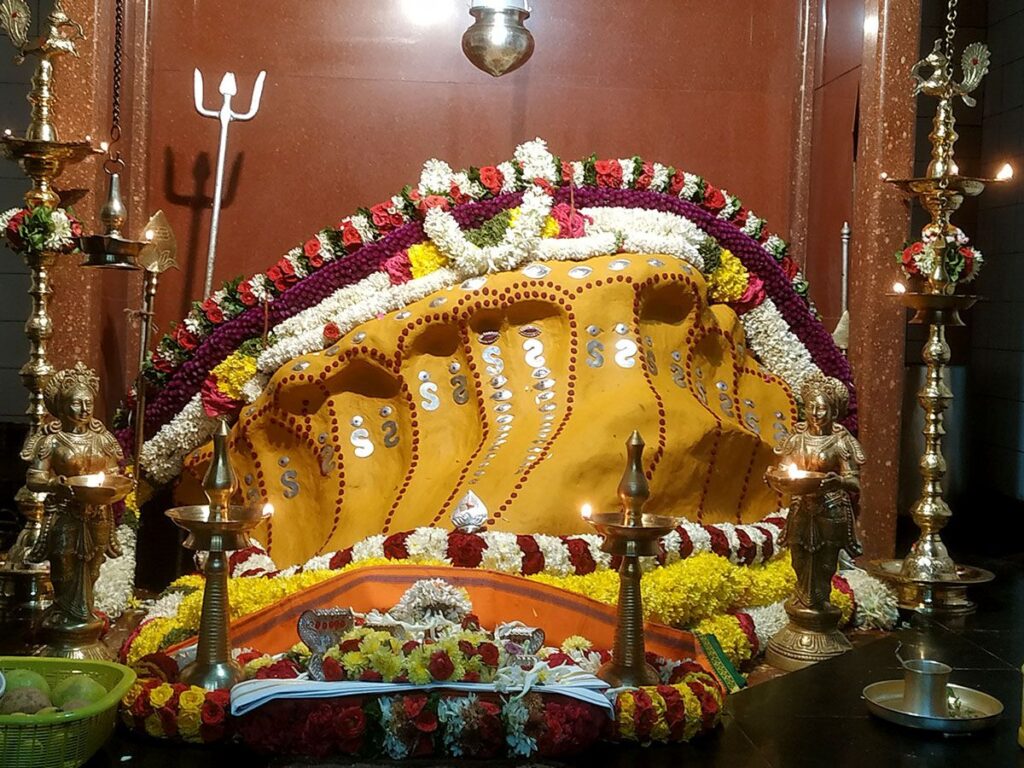
Contents
- 1 Swayambhu Nagaraja Temple History:
- 2 Significance of Padarayanapura Temple:
- 3 Myths of Swayambhu Nagaraja Temple:
- 4 Swayambhu Nagaraja Temple Architecture:
- 5 Swayambhu Nagaraja Temple Timing and Rituals:
- 6 Places to visit near Swayambhu Nagaraja Temple:
- 7 FAQ:
- 8 How to reach Swayambhu Nagaraja Temple:
- 9 Google Maps:
Swayambhu Nagaraja Temple History:
The history of Swayambhu Nagaraja Temple in Bengaluru dates back to 1969. Here’s a timeline of some key events:
- 1969: The land where the temple stands was covered with rocks, trees, and thorn bushes. On a Thursday afternoon, a self-formed stone resembling Lord Subramanya was discovered by the landowners, B. Veeranagoudru and Mandi Rudrappa.
- Early 1970s: The initial years saw the emergence of a small temple structure around the self-formed stone.
- 1976: A major consecration ceremony called Maha Kumbabishekam was performed.
- 1977: To manage the temple’s affairs effectively, a trust – Sri Swayambhu Nagaraja Bala Subramanya Swamy Temple Trust – was established with the permission of the landowners.
Read More>> Kabbalamma Temple Kanakapura
Significance of Padarayanapura Temple:
- Self-formed Deities: The temple is particularly known for its self-formed deities. According to the Swayambhu Nagaraja Temple’s history, the main idol, Sri Subramanya Swamy, was discovered as a small stone and is believed to have grown over time. This uniqueness attracts devotees.
- Holy Kalyani: The temple’s holy water pond, known as the Kalyani, is believed to have healing properties and is famous for curing diseases and problems faced by devotees.
- Granting Wishes: Devotees believe that prayers offered here, especially through performing sevas or pujas, are particularly effective. The temple is associated with helping people with marriage, childbirth, and other wishes.
- Social Service: The temple trust is involved in social service activities such as clothes donation, blood donation camps, and polio vaccination drives, adding to its significance in the community.
Read More>> Kateramma Temple Hoskote Kambalipura
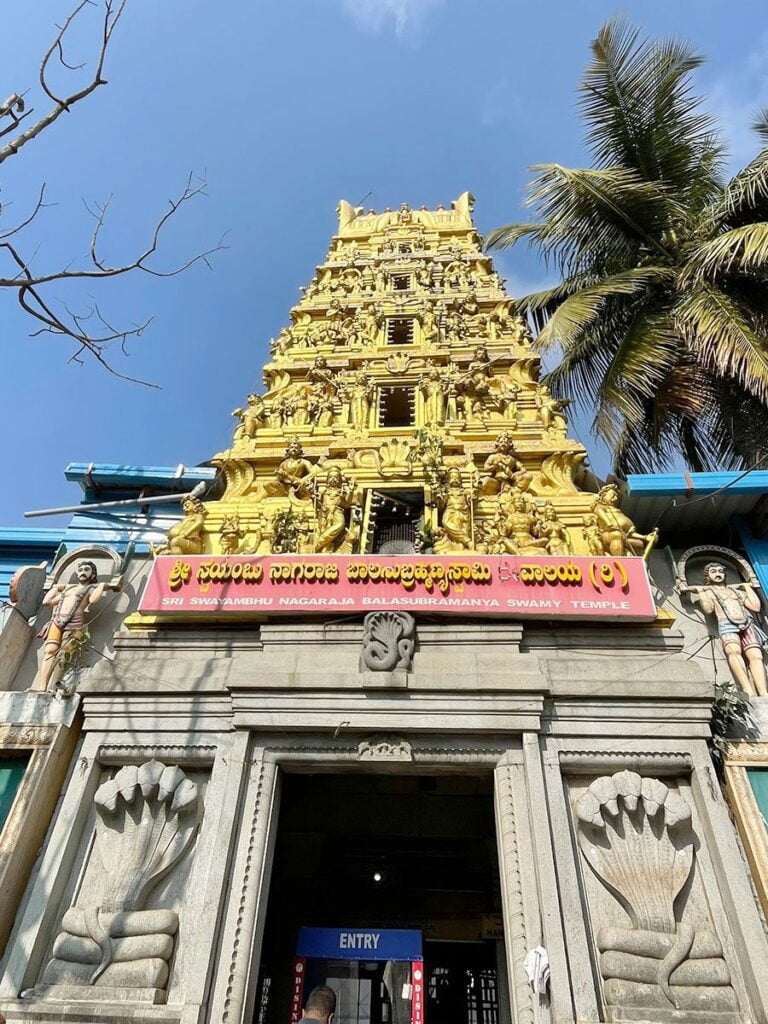
Myths of Swayambhu Nagaraja Temple:
- Self-manifested deity: The central belief is that the idol of Nagaraja (snake god) is a “Swayambhu,” meaning self-formed. This imbues the idol with a special significance and power.
- Divine possession: The Swayambhu Nagaraja Temple recounts instances of a man named Nagaraju becoming possessed by the deity Nagappa Swami and Mother Rajarajeshwari. During these possessions, Nagaraju would reportedly perform snake-like movements or dance with fire.
- Holy well with endless water: The temple well, though shallow (around 15 feet deep), is believed to have an endless supply of water, meeting the needs of all devotees.
- Wish-fulfilling Kalyani: The temple pond, called Kalyani, is said to have healing properties and the ability to grant wishes of devotees who bathe in its waters.
- Miracle of the Hombale tree: The temple grounds have a Hombale tree (sacrificial fire offering stand). Myth suggests that when the dried Hombale leaves fall, they resemble snake skin.
Read More>> Horanadu Annapoorneshwari Temple
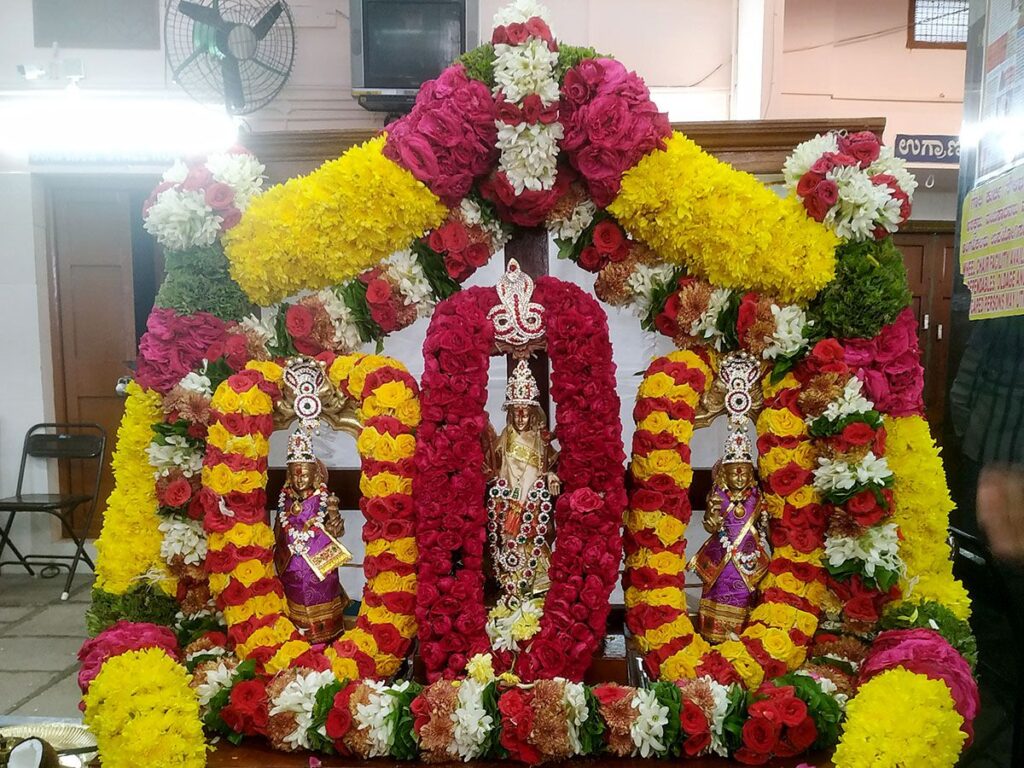
Swayambhu Nagaraja Temple Architecture:
Modern Construction
The core of the temple complex is a modern building that houses the main sanctum and other shrines. This building has a large gopuram (tower) at the entrance, which is a common feature in South Indian temple architecture. The gopuram is a relatively new structure, built in the 1970s.
Traditional Elements
Within the temple complex, there are also some traditional elements, such as a mandapa (hall) with pillars and a prakara (circumambulation path) around the main sanctum. The Swayambhu Nagaraja Temple also has a number of smaller shrines dedicated to other deities.
Uniqueness
One of the unique features of the temple is the main sanctum, which is said to be built around the original natural rock formation. The sanctum is believed to have a sand floor and thatched roof, which are said to be more conducive to snakes. There are also a number of serpent sculptures around the temple complex, reflecting the dedication to Nagaraja, the king of snakes.
Read More>> Gavi Gangadhareswara Temple Karnataka
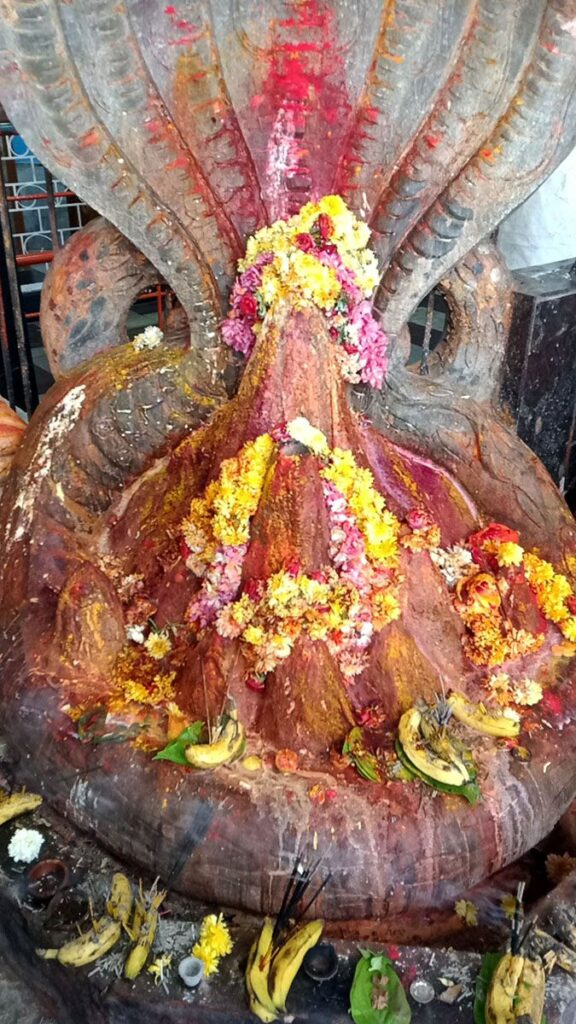
Swayambhu Nagaraja Temple Timing and Rituals:
- Temple Timings:
- Monday to Saturday: 7:30 am to 12:30 pm and 4:30 pm to 7:30 pm
- Sunday: 7:30 am to 7:30 pm
- Special Occasions: 7:30 am to 9:00 pm
- Unique Features:
- The temple is renowned for its simple procedures in solving devotees’ problems.
- All the Shaiva deities are uniquely formed here.
- The temple’s Holy Kalyani is famous for its healing properties.
- Prasadam is distributed twice a week.
- Social Services:
- Clothes distribution for the poor and needy.
- Blood donation drives.
- Polio vaccination campaigns (held once a year).
- Bhakti Sinchana:
- Singer Rajesh Krishnan produced an album titled “Sri Swayambhu Nagaraja Balasubramanya Swamy: Bhakti Sinchana” dedicated to the temple.
- 46th Anniversary:
- After three years of Covid lockdown, the temple celebrated its 46th anniversary with various events, including homas, poojas, anna dhaana, pallaki utsava, and prasada distribution.
Read More>> 7th Century Virupaksha Temple Hampi
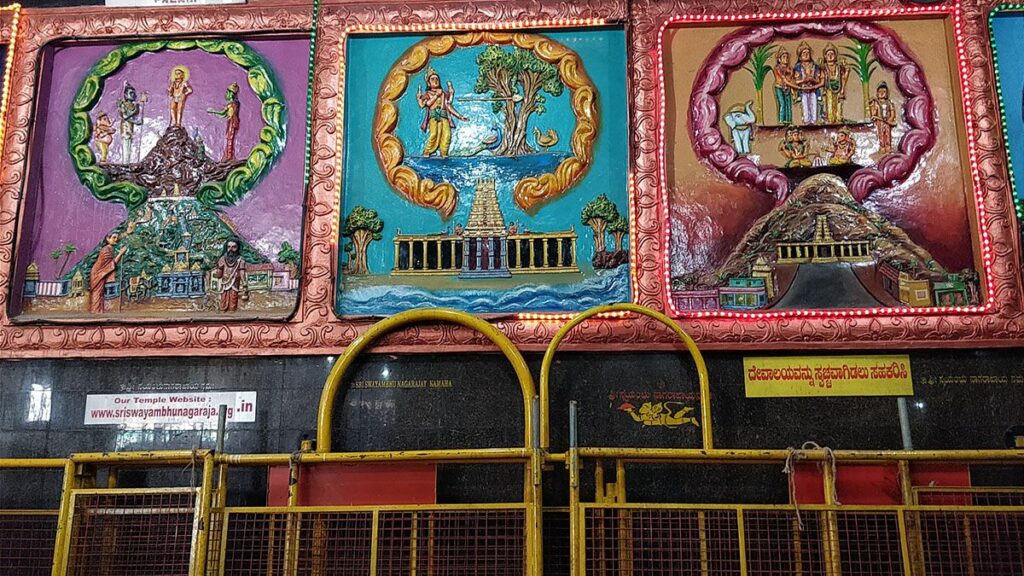
Places to visit near Swayambhu Nagaraja Temple:
- Lalbagh Botanical Garden:
- A beautiful botanical garden with a wide variety of plants, flowers, and a glasshouse. It’s a great place for nature lovers and those seeking a peaceful environment.
- Cubbon Park:
- Another green oasis in the heart of the city, Cubbon Park offers walking paths, landscaped gardens, and historical buildings. It’s a perfect place for a leisurely stroll.
- Bangalore Palace:
- A stunning Tudor-style palace with beautiful architecture, Bangalore Palace is open to the public and provides a glimpse into the city’s royal history.
- Vidhana Soudha:
- The seat of the state legislature of Karnataka, Vidhana Soudha is an impressive building with neo-Dravidian architecture. It’s an iconic landmark in Bangalore.
- Tipu Sultan’s Summer Palace:
- This historic palace was the summer residence of Tipu Sultan, the ruler of Mysore. It showcases his life and achievements through artifacts and paintings.
- ISKCON Temple Bangalore:
- The International Society for Krishna Consciousness (ISKCON) Temple in Bangalore is a serene and spiritually significant place. It attracts devotees and tourists alike.
- Wonderla Amusement Park:
- For those seeking thrills and entertainment, Wonderla is a popular amusement park with a variety of rides, water attractions, and shows.
- Nandi Hills:
- Located a bit outside Bangalore, Nandi Hills offers a scenic getaway with panoramic views. It’s a great place for a day trip or a weekend retreat.
- National Gallery of Modern Art (NGMA):
- Art enthusiasts can explore NGMA, which houses a rich collection of modern and contemporary Indian art.
- Ulsoor Lake:
- Ulsoor Lake is one of the several lakes in Bangalore where visitors can enjoy boating and a peaceful lakeside atmosphere.
- Innovative Film City:
- This entertainment complex offers a variety of attractions, including a wax museum, mini-golf, and themed zones.
- Commercial Street and MG Road:
- Shopaholics can explore the bustling Commercial Street and MG Road for a range of shops, boutiques, and eateries.
FAQ:
About the Temple
- What is the significance of the temple? The Swayambhu Nagaraja Templeis dedicated to Lord Shiva, specifically Swayambhu Nagaraja, a self-formed manifestation. It’s known for the “Holy Kalyani” (holy well) with water believed to have healing properties.
- How old is the temple? The temple was built around 50 years ago.
Visiting the Temple
- Temple timings: Information on specific timings is not readily available online. It’s best to contact the temple directly through their website [Sri Swayambhu Nagaraja Balasubramanya Swamy Temple] for current darshan (visit) hours.
- Does the temple offer prasadam (blessed food)? Yes, prasadam is served free of charge two days a week.
- Is there a dress code? There is no mention of a strict dress code. However, dressing modestly and respectfully is always a good practice when visiting any religious place.
Unique Features
- Self-formed deities: The Swayambhu Nagaraja Temple is known for its self-formed representations of the divine, including the head of Lord Dakshinamurthy in peach stone, said to be one-of-a-kind.
- Holy Kalyani: The temple well is a source of holy water, believed to be beneficial for health problems.
How to reach Swayambhu Nagaraja Temple:
By Road:
- Bus:
- Bangalore has an extensive bus network operated by BMTC (Bangalore Metropolitan Transport Corporation). You can check the BMTC website or use mobile apps to find buses that connect to Padarayanapura from your location.
- Identify the nearest bus stop, and you may need to take a local bus or auto-rickshaw from there to reach Padarayanapura.
- Auto-rickshaw / Taxi:
- Auto-rickshaws and taxis are readily available in Bangalore. You can hire an auto-rickshaw or taxi to reach Padarayanapura directly.
By Metro:
- Check if the Bangalore Metro has a station near your location. If so, you can use the metro service to reach the nearest station, and then take a taxi, auto-rickshaw, or bus to Swayambhu Nagaraja Temple.
By Train:
- Bangalore has several railway stations. If you are arriving by train, you can reach Padarayanapura by hiring a taxi, auto-rickshaw, or using local bus services.
By Air:
- If you are arriving by air, Kempegowda International Airport is the primary airport in Bangalore. From the airport, you can hire a taxi or use airport shuttle services to reach Swayambhu Nagaraja Temple.

One Comment